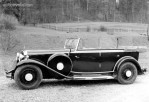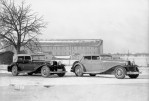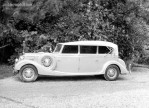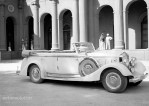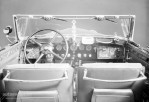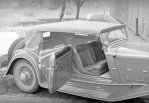Segment: Luxury
Production years: 1930, 1931, 1932, 1933
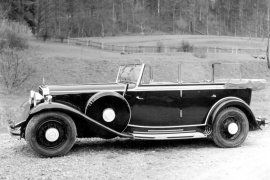 9 Photos
9 PhotosAfter WWI, Maybach was no longer allowed to build engines for aircraft, so it turned its attention toward the blooming car industry and made some of the most luxurious and exclusive vehicles from those times.
In 1930, the German carmaker introduced the Zeppelin Doppel-Sechs (double-six) luxury vehicle offered as a chassis-cab, a closed-body, or a convertible. The Maybach-Motorenbau badge was already known, and, despite the economic crisis of those times, the DS7 managed to find customers.
Karl Maybach designed the big vehicle with deep-pocket customers in mind. The result was a luxurious vehicle that sported the Zeppelin badge in front of the radiator, mounted on an arched bar supported by the front fenders between the headlights. A thick metallic bumper mounted on the chassis' endings gave the car a more robust appearance. But the front fenders also served as supports for the spare wheels, one on each side of the vehicle, flanking the engine compartment. In addition, Maybach offered the DS7 with two or three side windows, depending on the car's length. The shorter one was sportier, designed especially for the driver, not the passengers.
Inside, unlike the hard-top version, the Cabriolet featured four seats, with more room for the rear ones on the long-wheelbase version. This model was also made for officials, country rulers, or kings to stand up and salute their people if they wished so. Maybach took care of everything and used only expensive materials: leather, wood trims, and even gold.
Under the big, long hood, Maybach installed a seven-liter, naturally aspirated V12 engine. Even though it produced just a mere 150 PS (148 hp), that was enough to propel the car with 150 kph (93 mph). Moreover, unusually for those times, the car was fitted with power brakes in all corners.
MAYBACH Typ Zeppelin Doppel-Sechs 7 Liter (DS 7) Cabriolet 1930, 1931, 1932, 1933
- 7.0 V12
- 7.0 V12 Lang
MAYBACH Typ Zeppelin Doppel-Sechs 7 Liter (DS 7) Cabriolet
7.0 V12
ENGINE SPECS - 7.0 V12 | |
|---|---|
| Cylinders: | V12 |
| Displacement: | 6967 cm3 |
| Power: | 110 KW @ 3000 RPM 150 HP @ 3000 RPM 148 BHP @ 3000 RPM |
| Fuel System: | Carburetors |
| Fuel: | Gasoline |
PERFORMANCE SPECS | |
|---|---|
| Top Speed: | 93 mph (150 km/h) |
TRANSMISSION SPECS | |
|---|---|
| Drive Type: | Rear Wheel Drive |
| Gearbox: | Sequential, 4 Speed |
BRAKES SPECS | |
|---|---|
| Front: | Drums |
| Rear: | Drums |
TIRES SPECS | |
|---|---|
| Tire Size: | 7.00-20 |
DIMENSIONS | |
|---|---|
| Length: | 211.4 in (5370 mm) |
| Width: | 71.7 in (1821 mm) |
| Height: | 70.9 in (1801 mm) |
| Front/rear Track: | 58.7/58.7 in (1,491/1,491 mm) |
| Wheelbase: | 144.1 in (3660 mm) |
FUEL ECONOMY (NEDC) | |
|---|---|
| Combined: | 9 mpg US (26.1 L/100Km) |
| CO2 Emissions: | 622 g/km |
MAYBACH Typ Zeppelin Doppel-Sechs 7 Liter (DS 7) Cabriolet
7.0 V12 Lang
ENGINE SPECS - 7.0 V12 Lang | |
|---|---|
| Cylinders: | V12 |
| Displacement: | 6967 cm3 |
| Power: | 110 KW @ 3000 RPM 150 HP @ 3000 RPM 148 BHP @ 3000 RPM |
| Fuel System: | Carburetors |
| Fuel: | Gasoline |
PERFORMANCE SPECS | |
|---|---|
| Top Speed: | 93 mph (150 km/h) |
TRANSMISSION SPECS | |
|---|---|
| Drive Type: | Rear Wheel Drive |
| Gearbox: | Sequential, 4 Speed |
BRAKES SPECS | |
|---|---|
| Front: | Drums |
| Rear: | Drums |
TIRES SPECS | |
|---|---|
| Tire Size: | 7.00-20 |
DIMENSIONS | |
|---|---|
| Length: | 216.5 in (5499 mm) |
| Width: | 71.7 in (1821 mm) |
| Height: | 70.9 in (1801 mm) |
| Front/rear Track: | 58.7/58.7 in (1,491/1,491 mm) |
| Wheelbase: | 147 in (3734 mm) |
FUEL ECONOMY (NEDC) | |
|---|---|
| Combined: | 8.4 mpg US (28 L/100Km) |
| CO2 Emissions: | 666 g/km |

